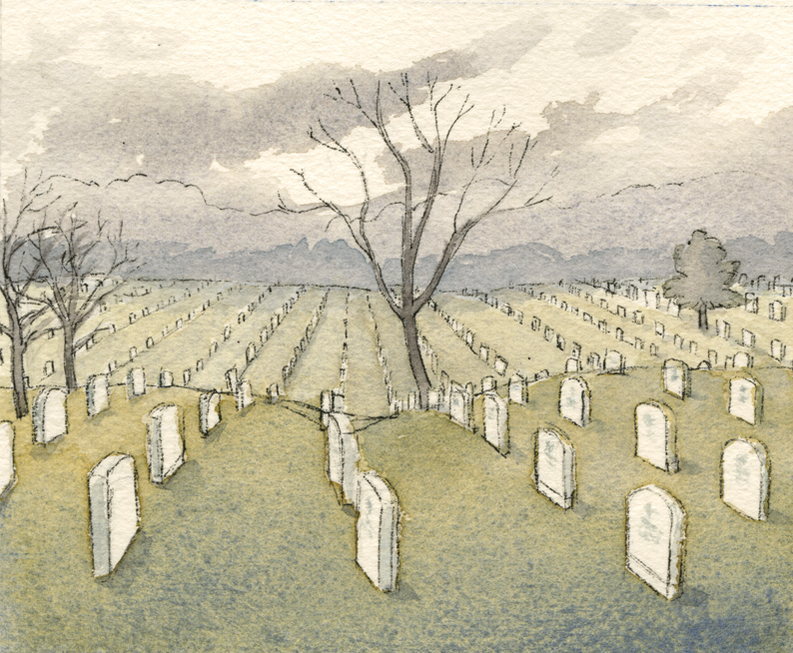Arlington House Endnotes: Live URL Edition
January 21, 2018If you haven’t yet, read the comic at The Nib.
I wasn’t able to include linked URLs with that version, so I have provided them below. But first, some thoughts and thank yous:
Some Thoughts
My comic is a history of Arlington House, not the history of Arlington House. There is so much more to the stories surrounding Arlington House than I was able to include, from the land’s early use as as quarries for indigenous peoples during the Late Archaic period (3,000 – 1200 BCE) all the way through the renovations currently underway. I would recommend the books and articles included in the endnotes to anyone curious about history and how narratives and places shape our understanding of the past.
History is messy. Sometimes versions of events conflict, or information is misinterpreted. After all, it’s created by people, recorded by people, remembered, studied, and interpreted by people. However, I have tried my best to seek out primary sources and choose accurate, well-researched secondary sources. If the story contains errors, the responsibility for it is mine alone.
Thank You
Thank you to first readers and JEMS peer crit and support group for feedback, and Michelle Tafur for taking reference photographs for me at Arlington House.
Thank you to the Ragdale Foundation, where I worked on a draft during their themed residency in fall 2017. Thanks also to professor Mueller at the University of Hartford, who mentioned Arlington House in passing in a Civil War class lecture (2008?) which planted the seed of curiosity, and to Dr. DiFuria at Savannah College of Art and Design, whose art history course on ruins in 2012 allowed me to explore my curiosity about Arlington House in the context of architecture and ruins.
Thank you to Jessica Abel, Benjamin Frisch, and the Out on the Wire Working Group, which helped me re-frame the story early on.
Russell Berman’s article in The Atlantic last August about recent changes at Arlington House gave me the impetus to pitch a story on Arlington House to The Nib a second time, and is how I learned where to find scans of old Congressional resolutions online.
Endnotes
1. These 153 people were considered “dower slaves” under Virginia law, meaning that Martha Washington had life rights over them but not ownership, which is why they remained enslaved after her death.
2. Mary V. Thompson, “Private Lives of Slaves,” Mount Vernon Estate and Gardens,
http://www.mountvernon.org/digital-encyclopedia/article/private-lives-of-slaves/
3. Robert M. Poole, On Hallowed Ground: The Story of Arlington National Cemetery (USA: Bloomsbury, 2009), 36.
4. To be clear, G.W.P. Custis allegedly raped and
impregnated multiple enslaved women. See note 5.
5. All panel text, beginning with “During his lifetime…” is from Elizabeth Brown Pryor, Reading the Man: A Portrait of Robert E. Lee Through His Private Letters (Viking, 2007), 138 – 139.
6. United States Department of the Interior, National Park Service/ National Register of Historic Places Registration Form: Arlington House Historic District: 2013 Boundary Increase & Additional Documentation, Section 8, page 52, https://www.nps.gov/nr/feature/places/pdfs/R_A_14000067.pdf
7. Poole, On Hallowed Ground, 14.
8. There were several reasons for this, including comments Custis supposedly made to Arlington slaves during his lifetime and on his deathbed. See Brown Pryor, 264 – 265.
9. Poole, On Hallowed Ground, 14.
10. Brown Pryor, Reading the Man, 264. It was more profitable to hire out slaves to work for others. Hiring out was a departure from the Custis practice of keeping families together.
11. Brown Pryor, Reading the Man, 270.
12. Bertram Wyatt-Brown, Honor and Violence in the Old South, (Oxford University Press, 1986), 58. For examples of Lee’s racism during and after the Civil War, see Eric Foner, “The Making and Breaking of the Legend of Robert E. Lee,” The New York Times, book review (Aug. 28, 2017), https://nyti.ms/2wcvOJm.
13. About two-fifths of U.S. military officers from Virginia remained in the Union army after the state seceded. See Elizabeth Brown Pryor, Reading the Man, 292.
14. Robert M. Poole, “How Arlington National Cemetery Came to Be,” Smithsonian Magazine, (November, 2009), http://www.smithsonianmag.com/history-archaeology/The-Battle-of-Arlington.html
15. Robert M. Poole, “How Arlington National Cemetery Came to Be.”
16. Robert M. Poole, “How Arlington National Cemetery Came to Be.”
17. The Lee’s son Washington Lee eventually won the property back through the courts, but then sold it back to the government.
18. Rollin G. Osterweis, The Myth of the Lost Cause 1865 – 1900, (Archon Books, 1973), x.
19. Osterweis, The Myth of the Lost Cause 1865 – 1900, 21.
20. United States Congress, Joint Resolution Authorizing the Restoration of the Lee Mansion in the Arlington National Cemetery, Virginia. March 4, 1925, page 1356. https://www.loc.gov/law/help/statutes-at-large/68th-congress/c68.pdf
21. Image and caption after photo in Eric Foner, Give Me Liberty! Vol. 2, (New York:W.W. Norton & Co., 2005), 791.
22. Eric Foner, Give Me Liberty! Vol. 2, 792.
23. Eric Foner, Give Me Liberty! Vol. 2, 793.
24. Eric Foner, Give Me Liberty! Vol. 2, 793.
25. United States Congress, Joint Resolution Dedicating the Lee Mansion in Arlington National Cemetery as a Permanent Memorial to Robert E. Lee., June 29, 1955, page 190,https://www.gpo.gov/fdsys/pkg/STATUTE-69/pdf/STATUTE-69-Pg190.pdf
26. National Park Service, “Jim Parks,”https://www.nps.gov/arho/learn/historyculture/parks.htm
***
Patreon note: If you would like to, and have the means, you can pledge a dollar to my Patreon page. It’s essentially a tip jar for recurring monthly payments. The posts you see here are duplicated over on Patreon, and are available publicly, for free.
Thank you for reading.
Yours in footnotes,
Jackie
